Android App 保活服务的配置与禁用
- 2022 年 9 月 29 日 北京
本文字数:6302 字
阅读完需:约 21 分钟
Android 应用保活是应用、系统、用户三个角色相互影响的产物。几乎每一款应用都希望自己能实现永久保活,并通过保活实现消息推送、信息上报等等交互行为;几乎所有的系统厂商都想把应用关在笼子里,通过控制应用的运行时间来避免过多的电量和性能的消耗,这样可以大大提高系统流畅度和手机使用时间;对于用户来说我们希望使用的时候应用可以更好的运行,比如音乐、导航、通信软件,但是我们又希望不使用时彻底关闭应用,但是大部分用户都不清楚如何彻底关闭一个应用并让它不再运行。那么本文介绍一下在 Android 系统里面是如何实现保活方案,如何启动或禁用应用的保活。
Android 应用自启与白名单
Android 应用的保活一般会从两个方面着手:一是如何提高应用的存活周期;二是如何唤醒关闭的应用。一般情况下会通过 Android 账户的自动同步机制和开机广播唤醒已关闭的应用;然后通过定时任务、前台服务、在屏幕上显示控件等方式提高应用的存活周期。在账户同步的服务和开机广播接收器中为应用开启一个前台 Service 就实现了应用保活的基本策略。下面分别介绍各个方式的实现。
Android 应用自启与白名单
通过静态注册开机广播可以在系统启动时唤醒应用,应用被唤醒后可以检查并初始化前台服务等保活策略。
public class BootReceiver extends BroadcastReceiver { @Override public void onReceive(Context context, Intent intent) { //检查并初始化前台服务等保活策略 }}<receiver android:name=".receiver.BootReceiver" android:directBootAware="true" android:enabled="true" android:exported="true"> <!--通过priority指定广播的优先级--> <intent-filter android:priority="2147483647"> <action android:name="android.intent.action.BOOT_COMPLETED" /> <action android:name="android.intent.action.LOCKED_BOOT_COMPLETED" /> </intent-filter> </receiver>账户同步机制
Android 应用可以在运行时注册系统账户,并通过 service 与系统账户进行关联,当系统运行时会在特定时期同步账户,同步账户的时候会启动所关联的 service,在关联 service 中可以检查保活方案,通过账户同步机制可以唤醒被关闭的应用。
在开始之前首先定义两常量,在文中通过{常量名}的方式方式指代:
accountType=“xxxxxx”
contentAuthority=“xxxx”
<?xml version="1.0" encoding="utf-8"?>
<sync-adapter xmlns:android="http://schemas.android.com/apk/res/android" android:accountType="{accountType}" android:allowParallelSyncs="false" android:contentAuthority="{contentAuthority}" android:isAlwaysSyncable="true" android:supportsUploading="true" android:userVisible="true" /><?xml version="1.0" encoding="utf-8"?>
<account-authenticator xmlns:android="http://schemas.android.com/apk/res/android" android:accountType="com.qihoo.qa.ticker.account" android:icon="@mipmap/ic_launcher" <!--在系统设置中显示的账户图标--> android:label="@string/app_name" /><!--在系统设置中显示的账户名称-->public class AccountSyncProvider extends ContentProvider { @Override public boolean onCreate() { return false; }
@Nullable @Override public Cursor query(@NonNull Uri uri, @Nullable String[] projection, @Nullable String selection, @Nullable String[] selectionArgs, @Nullable String sortOrder) { return null; }
@Nullable @Override public String getType(@NonNull Uri uri) { return null; }
@Nullable @Override public Uri insert(@NonNull Uri uri, @Nullable ContentValues values) { return null; }
@Override public int delete(@NonNull Uri uri, @Nullable String selection, @Nullable String[] selectionArgs) { return 0; }
@Override public int update(@NonNull Uri uri, @Nullable ContentValues values, @Nullable String selection, @Nullable String[] selectionArgs) { return 0; }}<providerandroid:name=".account.AccountSyncProvider"android:authorities="{contentAuthority}"android:enabled="true"android:exported="true" />public class AuthenticationService extends Service {
private AccountAuthenticator accountAuthenticator;
@Nullable @Override public IBinder onBind(Intent intent) { return accountAuthenticator.getIBinder();//返回binder对象供系统使用 }
@Override public void onCreate() { super.onCreate(); accountAuthenticator = new AccountAuthenticator(this); }
public static class AccountAuthenticator extends AbstractAccountAuthenticator {
public AccountAuthenticator(Context context) { super(context); }
@Override public Bundle editProperties(AccountAuthenticatorResponse response, String accountType) { return null; }
@Override public Bundle addAccount(AccountAuthenticatorResponse response, String accountType, String authTokenType, String[] requiredFeatures, Bundle options) throws NetworkErrorException { return null; }
@Override public Bundle confirmCredentials(AccountAuthenticatorResponse response, Account account, Bundle options) throws NetworkErrorException { return null; }
@Override public Bundle getAuthToken(AccountAuthenticatorResponse response, Account account, String authTokenType, Bundle options) throws NetworkErrorException { return null; }
@Override public String getAuthTokenLabel(String authTokenType) { return null; }
@Override public Bundle updateCredentials(AccountAuthenticatorResponse response, Account account, String authTokenType, Bundle options) throws NetworkErrorException { return null; }
@Override public Bundle hasFeatures(AccountAuthenticatorResponse response, Account account, String[] features) throws NetworkErrorException { return null; } }}<service android:name=".account.AuthenticationService"> <intent-filter> <action android:name="android.accounts.AccountAuthenticator" /> </intent-filter> <meta-data android:name="android.accounts.AccountAuthenticator" android:resource="@xml/account_authenticator" /> <!--指定账户配置文件--></service>public class AccountSyncService extends Service {
private SyncAdapter mSyncAdapter;
private static final String TAG = "SyncService";
@Nullable @Override public IBinder onBind(Intent intent) { return mSyncAdapter.getSyncAdapterBinder(); }
@Override public void onCreate() { super.onCreate(); mSyncAdapter = new SyncAdapter(getApplicationContext(), true); }
; public static class SyncAdapter extends AbstractThreadedSyncAdapter { public SyncAdapter(Context context, boolean autoInitialize) { super(context, autoInitialize); }
@Override public void onPerformSync(Account account, Bundle extras, String authority, ContentProviderClient provider, SyncResult syncResult) { //账户同步时回调此方法,在此处检测保活业务 } }}<service android:name=".account.AccountSyncService"<!--指定service文件--> android:enabled="true" android:exported="true"> <intent-filter> <action android:name="android.content.SyncAdapter" /> </intent-filter> <meta-data android:name="android.content.SyncAdapter" android:resource="@xml/account_sync_adapter" /><!--指定配置文件,该配置文件需要手动添加--></service>accountName="test"accountPwd="pwd"//添加账户 AccountManager accountManager = (AccountManager) context.getSystemService(Context.ACCOUNT_SERVICE); Account account = new Account(accountName, {accountType}); accountManager.addAccountExplicitly(account, accountPwd, new Bundle()); //设置账户同步 Account account = new Account(accountName, {accountType});// 下面三个都需要同一个权限 WRITE_SYNC_SETTINGS// 设置同步ContentResolver.setIsSyncable(account, {contentAuthority}, 1);// 自动同步ContentResolver.setSyncAutomatically(account, {contentAuthority}, true);// 设置同步周期ContentResolver.addPeriodicSync(account, {contentAuthority}, new Bundle(), 1);Schedule 定时任务
@RequiresApi(api = Build.VERSION_CODES.LOLLIPOP)public class LiveJobService extends JobService { @Override public boolean onStartJob(JobParameters params) { //执行任务时回调 return false; }
@Override public boolean onStopJob(JobParameters params) { return false; }}<service android:name=".service.LiveJobService" android:enabled="true" android:exported="true" android:permission="android.permission.BIND_JOB_SERVICE" /><!--指定服务权限-->JobScheduler jobScheduler = (JobScheduler) context.getSystemService(Context.JOB_SCHEDULER_SERVICE);//setPersisted 在设备重启依然执行JobInfo.Builder builder = new JobInfo.Builder(lastJobId+i, new ComponentName(context.getPackageName(),LiveJobService.class.getName())).setPersisted(true);// 50s后执行任务if (Build.VERSION.SDK_INT < Build.VERSION_CODES.N) { builder.setPeriodic(50000);} else { // 延迟执行任务 builder.setMinimumLatency(50000);}jobScheduler.schedule(builder.build());前台服务
保活服务一般在 Service 中后台运行,而 Android 系统对后台服务有一些列的运行限制,所以把服务绑定为前台服务会提高服务的优先级,在系统资源紧张时可以更好的运行。
/** * @author walker * @date 2020/12/25. * @description 在应用后台处理数据 */public class NotificationService extends Service {
@Nullable @Override public IBinder onBind(Intent intent) { return null; }
@Override public void onCreate() { super.onCreate(); }
@Override public int onStartCommand(Intent intent, int flags, int startId) { // 如果Service被终止 // 当资源允许情况下,重启service //绑定前台通知 if (Build.VERSION.SDK_INT >= Build.VERSION_CODES.O) { setForegroundService(); } return START_STICKY; }
/** * 通过通知启动服务 */ @androidx.annotation.RequiresApi(api = Build.VERSION_CODES.O) public void setForegroundService() { //设定的通知渠道名称 String channelName = "slient_name"; String CHANNEL_ID = "slient_id"; //设置通知的重要程度 int importance = NotificationManager.IMPORTANCE_LOW; //构建通知渠道 NotificationChannel channel = new NotificationChannel(CHANNEL_ID, channelName, importance); channel.setDescription("test"); //在创建的通知渠道上发送通知 NotificationCompat.Builder builder = new NotificationCompat.Builder(this, CHANNEL_ID); builder.setSmallIcon(R.drawable.ic_launcher) //设置通知图标 .setContentTitle("通知")//设置通知标题 .setContentText("前台服务")//设置通知内容 .setAutoCancel(true) //用户触摸时,自动关闭 .setOngoing(true);//设置处于运行状态 //向系统注册通知渠道,注册后不能改变重要性以及其他通知行为 NotificationManager notificationManager = (NotificationManager) getSystemService(Context.NOTIFICATION_SERVICE); notificationManager.createNotificationChannel(channel); //将服务置于启动状态 NOTIFICATION_ID指的是创建的通知的ID startForeground(111, builder.build()); }
@Override public void onDestroy() { super.onDestroy(); }}<!--通过android:process标签指定独立进程名--><service android:name=".service.DataService" android:enabled="true" android:exported="false" android:process=":sync" />在应用启动时开启服务
startService(new Intent(context,DataService.class));如何禁用后台运行
我们在开发或配置应用保活相关功能时主要通过开机自启、后台运行、关联启动、账户同步几个方面入手,不同的手机设置入口有可能不一样,但是可以参考这几点进行设置,下面介绍一下华为荣耀 20 上的配置方式。
01
开机自启权限的处理
以华为系统为例,在【手机管家】app 中找到【应用启动管理】,并在应用启动管理中找到对应的 app,将对应 app 切换为【手动管理】,并为激活【允许自动启动】【允许关联启动】【允许后台活动】三个选项。
允许设备开机自启以及后台服务的配置:
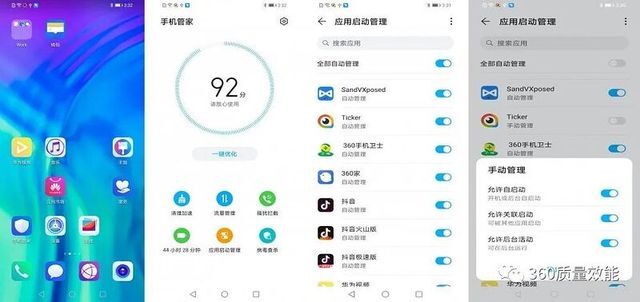
禁止后台服务以及开机自启的设置:
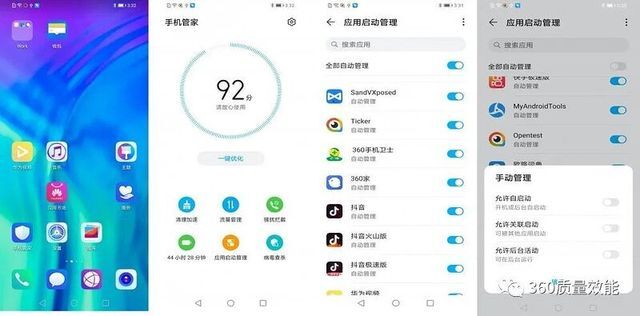
02
账户同步服务的处理
我们在【设置】/【账户】下可以看到系统内所有的账户信息,并可以在这里管理同步服务
允许账户同步设置:
允许账户同步时系统会按既定策略回调注册同步 Service,在 Service 内可以启动应用其他服务,但是部分机型上可能存在适配问题
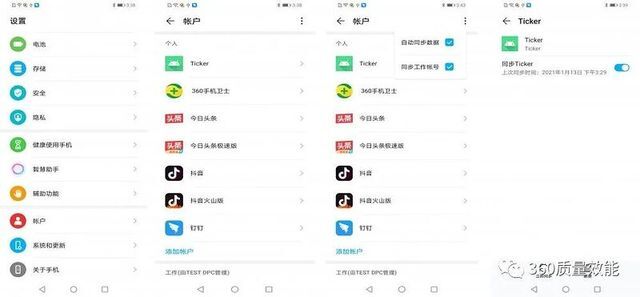
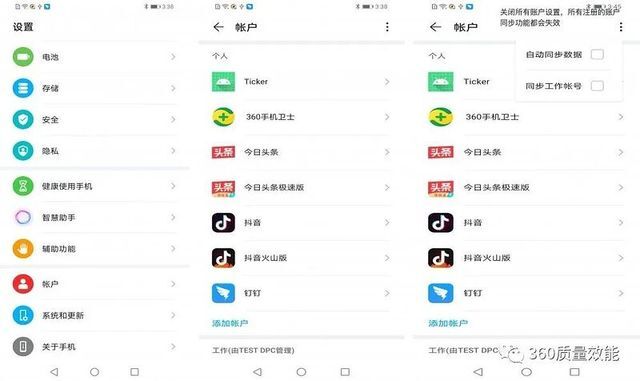
https://ceshiren.com/t/topic/22344
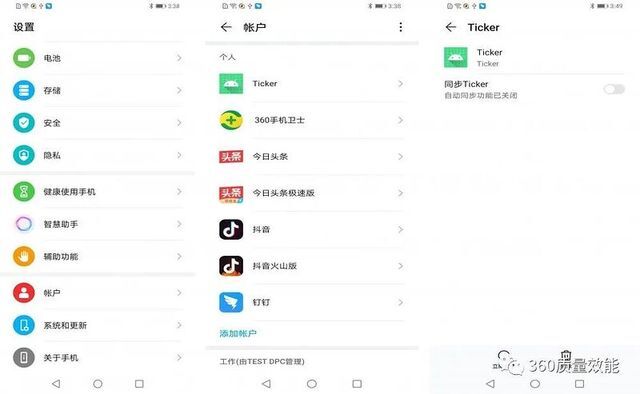
更多学习资料戳下方!!!
测吧(北京)科技有限公司
社区:ceshiren.com 2022.08.29 加入
微信公众号:霍格沃兹测试开发 提供性能测试、自动化测试、测试开发等资料、实事更新一线互联网大厂测试岗位内推需求,共享测试行业动态及资讯,更可零距离接触众多业内大佬











评论